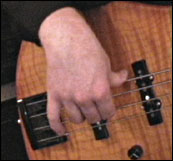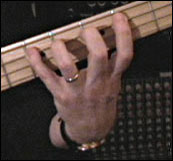 |
 |
| Online Bass Instruction with Rusty Springfield |
 |
|
|
|
|
 |
 |
| Holding and Playing the Instrument |
|
|
|
|
 |
|
|
|
|
Properly holding the bass can be one of the most overlooked topics when learning to play, yet it is one of the most important aspects. Ideally, your instrument should fit your body in an ergonomic manner. An overweight instrument can eventually cause back strain, as can poor posture. I like the bass to be in the same position when I'm standing as when I'm sitting with the instrument on my lap. This way, the same muscle groups are utilized, whether practicing or performing. When sitting, the bass is secured at three points: your lap, chest, and right forearm. Your forearm weight is what holds the bass in place, so that your left hand is free to play up and down the entire neck without having to support the weight of your instrument. |
|
|
|
|
 |
|
|
|
|
Right Hand Position

The thumb rests on the "E" string, which keeps it from ringing while giving the fingers better access to the remaining strings. |
|
|
|
|
Your Right Hand
Try placing your right hand just behind the first pickup with the thumb resting on either the pickup or on the E string. This gives you an "anchor" point from which to effectively pull the strings. I like to use the E string as a thumbrest because this position allows my right hand to have quick access to the other strings, plus it keeps the E string muted when I'm not using it. When I play the E string, I just slide my right thumb up along the body a half-inch or so, to give the E string just enough room to vibrate. Your right forearm acts as a fulcrum, so that the weight of your arm doesn't rest entirely on your right thumb. To get a mighty bass sound, firmly pull the string in a motion that also pushes down slightly on it, just before releasing it. This yields a very full, powerful attack. The pressure with which you play with your right hand is an integral part of the tone you produce. As you release the string, your finger stops on the adjacent string, keeping it from ringing sympathetically. Most players use the first and second fingers in an alternating fashion. With faithful practice, you can develop tremendous speed and dexterity using just these two fingers. Some players use their thumb to pluck downward (and sometimes upward) on the string. Some players use their 1st, 2nd, and 3rd fingers in combination with their thumb. There is no "right" way, just the one that works for you and your style.
|
|
|
|
|
 |
|
|
|
|
Left Hand Position

This photo illustrates the "one-finger-per-fret" position. Note that each finger presses just behind the fret. |
|
|
|
|
Your Left Hand
For the left hand positioning, I recommend using the "classical" technique, whereby the thumb acts as a guide along the middle or lower portion of the back of the neck. Your hand may then be rotated toward the front of the fingerboard, allowing more access for the fingers. Leave some space between your palm and the neck. I don't recommend keeping your palm in contact with the back of the neck, as I see many beginners do, because this cramps your hand motion and severely limits your fingers' ability to maneuver. The only exception to this would be when using the left hand thumb to mute the strings for a particular technique, such as slapping. Also, if you don't use your little finger already, start now. It will play a big part in your left hand's dexterity. |
|
|
|
|
 |
|
|
|
|
|
|
|


